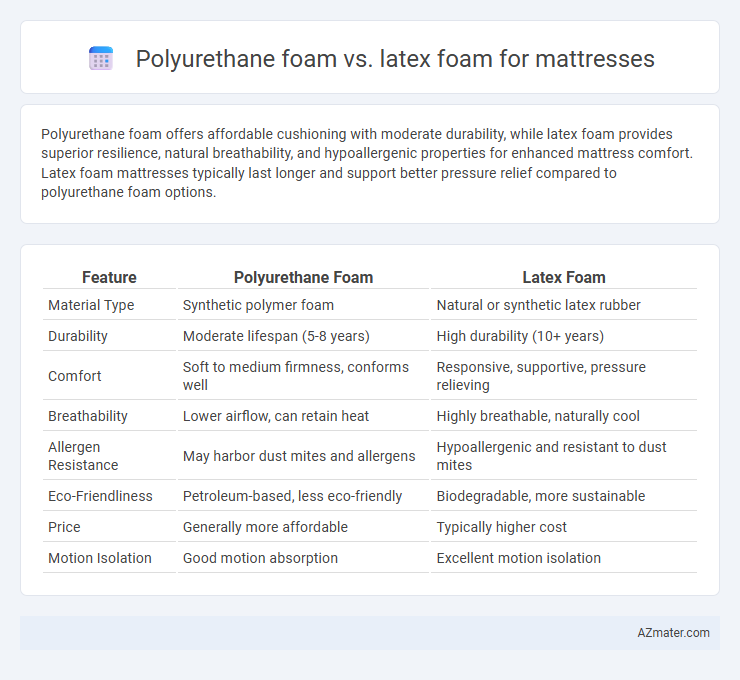Polyurethane foam offers affordable cushioning with moderate durability, while latex foam provides superior resilience, natural breathability, and hypoallergenic properties for enhanced mattress comfort. Latex foam mattresses typically last longer and support better pressure relief compared to polyurethane foam options.
Table of Comparison
| Feature | Polyurethane Foam | Latex Foam |
|---|---|---|
| Material Type | Synthetic polymer foam | Natural or synthetic latex rubber |
| Durability | Moderate lifespan (5-8 years) | High durability (10+ years) |
| Comfort | Soft to medium firmness, conforms well | Responsive, supportive, pressure relieving |
| Breathability | Lower airflow, can retain heat | Highly breathable, naturally cool |
| Allergen Resistance | May harbor dust mites and allergens | Hypoallergenic and resistant to dust mites |
| Eco-Friendliness | Petroleum-based, less eco-friendly | Biodegradable, more sustainable |
| Price | Generally more affordable | Typically higher cost |
| Motion Isolation | Good motion absorption | Excellent motion isolation |
Introduction to Polyurethane and Latex Foam Mattresses
Polyurethane foam mattresses consist of synthetic polymers offering durability and affordability, valued for their ability to provide versatile support and cushioning. Latex foam mattresses, derived from natural or synthetic latex, are recognized for superior elasticity, breathability, and resilience, promoting better pressure relief and moisture control. Both materials influence mattress comfort, durability, and hypoallergenic properties, informing consumer choices according to sleep preferences and budget.
What is Polyurethane Foam?
Polyurethane foam is a versatile synthetic material made from polymerized urethane, widely used in mattress manufacturing for its affordability and different density options that affect support and comfort. This foam adapts well to body contours but may vary in durability and breathability compared to natural alternatives. Its open-cell structure allows moderate airflow, making it a common choice for budget-friendly mattresses seeking balance between softness and resilience.
What is Latex Foam?
Latex foam is a natural material derived from the sap of rubber trees, known for its durability, breathability, and hypoallergenic properties, making it ideal for mattress construction. Unlike polyurethane foam, which is synthetic and prone to heat retention, latex foam offers superior temperature regulation and resilience, providing consistent support over time. Its eco-friendly production and antimicrobial qualities contribute to a healthier sleeping environment, distinguishing it as a premium choice in mattress materials.
Comfort and Support Comparison
Polyurethane foam mattresses offer firm support and durability but can feel less breathable and may retain heat, impacting comfort during extended use. Latex foam provides superior elasticity and natural responsiveness, promoting pressure relief and enhanced spinal alignment for better ergonomic support. Natural latex is hypoallergenic and temperature regulating, making it ideal for sleepers seeking a cooler, more breathable mattress option.
Durability and Longevity
Polyurethane foam mattresses generally offer moderate durability, with lifespan averaging around 5 to 7 years, depending on foam density and quality. Latex foam mattresses are known for superior longevity, often lasting 8 to 12 years or more due to natural resilience and resistance to sagging. High-density latex exhibits better compression resistance, maintaining support and shape longer compared to conventional polyurethane foam.
Breathability and Temperature Regulation
Polyurethane foam mattresses typically have lower breathability and trap more heat due to their dense structure, making them less effective at temperature regulation. Latex foam offers superior breathability because of its natural, open-cell structure, which promotes better airflow and keeps the sleeping surface cooler. Enhanced temperature regulation in latex foam helps reduce night sweats and maintains a comfortable sleeping climate throughout the night.
Allergy and Health Considerations
Polyurethane foam mattresses often contain chemical additives and off-gas volatile organic compounds (VOCs), which can trigger allergies and respiratory issues in sensitive individuals. Latex foam, especially natural latex, is inherently resistant to dust mites, mold, and mildew, reducing allergen exposure and promoting better indoor air quality. For allergy sufferers, natural latex foam provides a hypoallergenic sleep surface with fewer health risks compared to synthetic polyurethane foam.
Environmental Impact and Sustainability
Polyurethane foam is derived from petroleum-based chemicals, contributing to higher carbon emissions and limited biodegradability, whereas latex foam, especially natural latex, is sourced from sustainably harvested rubber trees and offers better biodegradability. Latex foam typically has a lower environmental footprint due to its renewable raw materials and longer mattress lifespan, reducing landfill waste compared to synthetic polyurethane foam. However, the processing of natural latex requires significant water and energy resources, highlighting the importance of sourcing certified eco-friendly latex for enhanced sustainability.
Cost Differences and Value
Polyurethane foam mattresses typically cost less than latex foam options, making them a budget-friendly choice for many consumers. Latex foam provides enhanced durability and natural resilience, often justifying its higher price with longer lifespan and better support. The value of latex foam lies in its hypoallergenic properties and eco-friendliness, while polyurethane foam offers affordability with decent comfort for short to medium-term use.
Which Mattress Foam is Best For You?
Polyurethane foam offers affordable support with good durability, making it suitable for budget-conscious sleepers seeking medium firmness. Latex foam provides superior breathability, natural hypoallergenic properties, and excellent contouring, ideal for those prioritizing eco-friendly materials and pressure relief. Choosing between the two depends on your preference for responsiveness, environmental impact, and specific sleep needs such as temperature regulation or allergen sensitivity.

Infographic: Polyurethane foam vs Latex foam for Mattress
 azmater.com
azmater.com